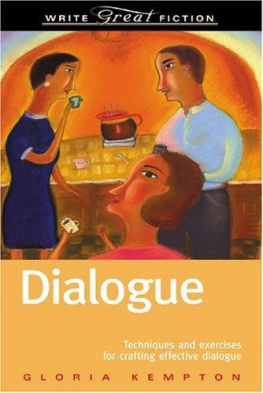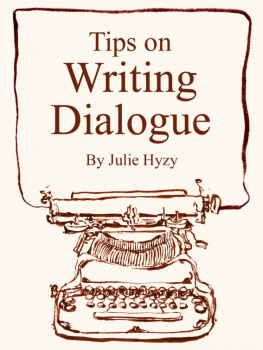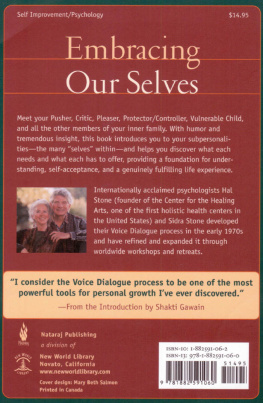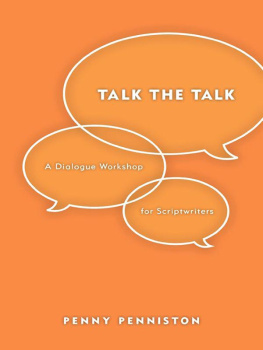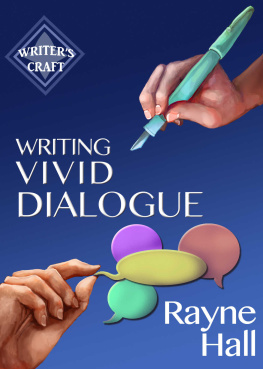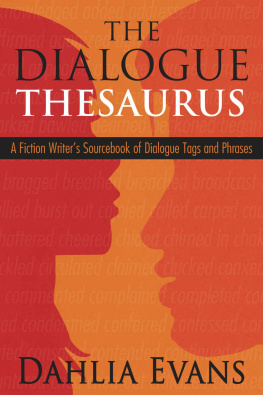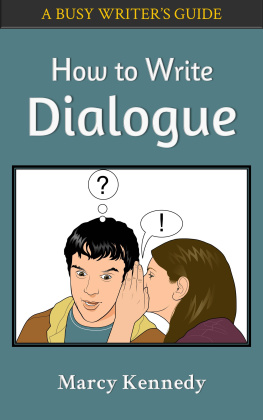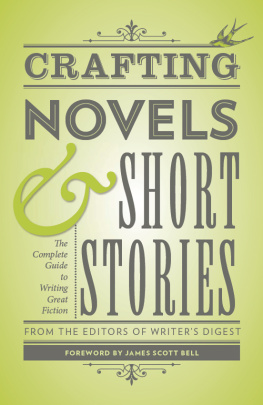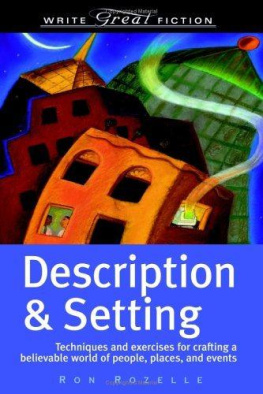Gloria Kempton - Write Great Fiction: Dialogue: Techniques and Exercises for Crafting Effective Dialogue
Here you can read online Gloria Kempton - Write Great Fiction: Dialogue: Techniques and Exercises for Crafting Effective Dialogue full text of the book (entire story) in english for free. Download pdf and epub, get meaning, cover and reviews about this ebook. year: 2011, genre: Romance novel. Description of the work, (preface) as well as reviews are available. Best literature library LitArk.com created for fans of good reading and offers a wide selection of genres:
Romance novel
Science fiction
Adventure
Detective
Science
History
Home and family
Prose
Art
Politics
Computer
Non-fiction
Religion
Business
Children
Humor
Choose a favorite category and find really read worthwhile books. Enjoy immersion in the world of imagination, feel the emotions of the characters or learn something new for yourself, make an fascinating discovery.
- Book:Write Great Fiction: Dialogue: Techniques and Exercises for Crafting Effective Dialogue
- Author:
- Genre:
- Year:2011
- Rating:5 / 5
- Favourites:Add to favourites
- Your mark:
- 100
- 1
- 2
- 3
- 4
- 5
Write Great Fiction: Dialogue: Techniques and Exercises for Crafting Effective Dialogue: summary, description and annotation
We offer to read an annotation, description, summary or preface (depends on what the author of the book "Write Great Fiction: Dialogue: Techniques and Exercises for Crafting Effective Dialogue" wrote himself). If you haven't found the necessary information about the book — write in the comments, we will try to find it.
Gloria Kempton: author's other books
Who wrote Write Great Fiction: Dialogue: Techniques and Exercises for Crafting Effective Dialogue? Find out the surname, the name of the author of the book and a list of all author's works by series.
Write Great Fiction: Dialogue: Techniques and Exercises for Crafting Effective Dialogue — read online for free the complete book (whole text) full work
Below is the text of the book, divided by pages. System saving the place of the last page read, allows you to conveniently read the book "Write Great Fiction: Dialogue: Techniques and Exercises for Crafting Effective Dialogue" online for free, without having to search again every time where you left off. Put a bookmark, and you can go to the page where you finished reading at any time.
Font size:
Interval:
Bookmark:




Dialogue is conversationnothing more, nothing less. How hard do we really think about the conversations in which we engage on a daily basis? How difficult do we make them? How much stress do we create for ourselves trying to make sure we pronounce every word correctly, say exactly what we mean, use the tone that reveals or hides our true feelings, arrange our body so it lines up with what we're saying, make sure we're giving the other person a chance to talk so we're not giving speeches... I'm exhausted just thinking about it. Of course we don't stress out this way when we're just standing on the sidewalk talking to a neighbor. But we do it when we're creating dialogue for our characters, which is what makes writing dialogue so very difficult.
But it's not difficult. We make it difficult.
That's my premise for this book. My goal is to break down the process of writing dialogue so it becomes more natural for writers, as natural as breathing and talkingtwo things we've been doing ever since we were born. Yes, we were talking as soon as we were breathing; we just didn't have the words. Just like we don't now breathe the way we naturally should (many of us walk around holding our breath), we also usually don't talk the way we'd like to be heard, so when we sit down to re-create dialogue we start thinking too hard about it and become paralyzed.
Somewhere along the line, someone tried to teach us how we should talk and then we learned how. We were praised for talking correctly and criticized for talking incorrectly.
"Mom, you don't have to yell, I can hear you."
"Don't use that tone with me, young man."
"Can I have more potatoes?"
"No, Susie, it's may I have more potatoes?"
"He's a dork, Mom."
"Don't call people namesit's not nice."
So here we are. We think we know how to talk correctly, so we don't worry about it so much in everyday conversation. But when we actually sit down to re-create dialogue on the page, suddenly we feel a lot of self-doubt and are faced with our own inadequacies. Maybe the real question we're asking at an unconscious level is not, "Can I write dialogue?" but "Am I talking correctly?" I don't know for sure, but I do know that we can make this process easier by doing something a little "zenny": When we're about to write a piece of dialogue, any dialogue, we must remember to forget.
Forget what?
That we're writing dialogue. We must slip inside of our characters and become them. From inside of our characters, we begin speaking. In the book Finding Your Writer's Voice: A Guide to Creative Fiction, authors Thaisa Frank and Dorothy Wall tell us this: "Great impersonators throw aside their own way of talking and take on the voice of another. As you work with character, letting yourself become possessed by this person, you want to abandon the automatic voice in your head that offers dialogue as you would speak it, and become the voice of this other person." Okay, it sounds like channeling. We've gone from Zen to New Age. Call it what you wantit works.
I've been writing dialogue for many years. I struggle with description, setting, and plot, but I seldom struggle with dialogue. I didn't know writers struggled with dialogue until I started coaching writers and heard them express their fears of not doing it "right."
I'm here to tell you there is no "right" wayI don't care what you've heard from other writing instructors and read in other writing books. There is only your way. Yours is the "right" way. And your job as writer is to learn to access the voice inside of yourself that you need for a particular piece of dialogue, no matter who's speaking it. Sure, you can do research, read books like this one, watch movies, and listen to how folks on the street talk. But ultimately, our characters come from somewhere inside of us, and if we want to be true to ourselves and our characters, whether fictional or real, we have to start giving them a voice.
As I prepared to write this book, I began to explore why dialogue has always come easily for me. I realized that it's because at a very early age,
when I began to read fiction, I became the characters I was reading about. I slipped into their heads, only to emerge when I'd finished the story. When I started to write my own stories at the tender age of nine, I had formed a useful writing habit: I became my characters. I easily slipped into my characters, speaking from inside their heads. I was all of them the sane to the insane, the kind to the brutal, the boring to the quirky.
You may wonder, "But how do I do that? How do I slip inside of my characters? How does that work, practically speaking? I'll be answering these questions in the following pages. You see, once we understand that our characters are not outside of us but within us, it takes the mystery out of how to write dialogue for any character. If we pull our characters up from inside of us instead of approach them from the outside, writing dialogue becomes an organic process.
Writing dialogue is simply giving a voice to the characters that live inside of us. I don't mean to make this sound spookyyou don't have to go into a dark room and turn around three times while repeating, "I love green eggs and ham."
All you have to do is want to write authentic dialogue. And when you let yourself do that, you'll discover the satisfaction in writing the kind of dialogue that delivers your character's true voice to the reader.
I have news for you. Not only is there no "right" way to write dialogue, and not only does writing dialogue not have to be as difficult as we like to make it, but writing dialogue can actually be fun.
My twofold mission in this book is: (1) to equip you with specific literary tools that will help you remember to forget that you're writing dialogue, which in turn will cause you to relax so your character's dialogue will emerge from who that character is, rather than from your personal agenda for the story, and (2) to remind you over and over again that the art of writing dialogue can be a lot of fun and is learned by exercising your freedom to color outside of the lines.
You'll find that this book will become your best friend on the journey to remember to forget you're writing dialogue and in your intention to no longer struggle but have fun learning to access the many voices inside of you.

[ releasing the voice within the purpose of dialogue ]
You're at the bookstore browsing through the fiction section. You're perusing titles, grabbing books off the shelf and skimming the back cover copy, then finally leafing through the novels one by one. Whether it's conscious or unconscious, guess what you're looking for.
Space. The eye is naturally drawn to space. Plenty of white space on each page. In a nonfiction book, that may mean text broken up with a subhead or sidebar here and there. In a novel that means dialogue.
Do you remember those novels teachers made us read in high school? Great Expectations. Madame Bovary. Lord of the Flies. Page after page of blocks of text. Long passages of boring narrative.
Font size:
Interval:
Bookmark:
Similar books «Write Great Fiction: Dialogue: Techniques and Exercises for Crafting Effective Dialogue»
Look at similar books to Write Great Fiction: Dialogue: Techniques and Exercises for Crafting Effective Dialogue. We have selected literature similar in name and meaning in the hope of providing readers with more options to find new, interesting, not yet read works.
Discussion, reviews of the book Write Great Fiction: Dialogue: Techniques and Exercises for Crafting Effective Dialogue and just readers' own opinions. Leave your comments, write what you think about the work, its meaning or the main characters. Specify what exactly you liked and what you didn't like, and why you think so.

